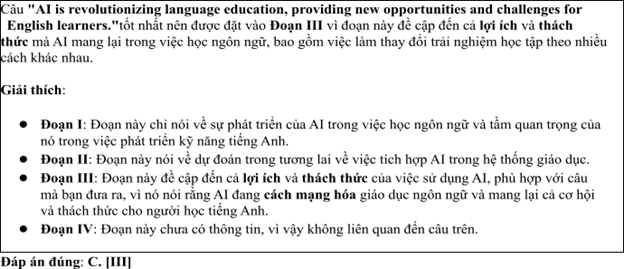[I] The use of Artificial Intelligence (AI) in language learning has grown substantially in recent years, and it has become an essential tool in the development of English skills. [II] Experts predict that by 2030, the integration of AI in educational systems will be widespread, transforming the way English is taught and learned worldwide. [III] The use of AI offers both advantages and challenges in this context, shaping the learning experience in various ways. [IV]
AI can assist language learners in several ways, enhancing both the learning process and the efficiency of acquiring English. For instance, AI-powered apps and software can help learners practice pronunciation, vocabulary, and grammar through interactive exercises. Moreover, AI systems can offer personalized learning experiences, adapting to each learner’s specific needs and pace, making language learning more effective. On the other hand, AI also presents challenges. Over-reliance on AI tools can lead to the reduction of human interaction, which is crucial for language acquisition. Without real conversations, learners may not fully develop their speaking and listening skills.
In terms of learning outcomes, the impact of AI on students varies. While AI can help students learn new words and structures quickly, it may also encourage passivity, as some learners may prefer passive modes of learning, such as watching videos or listening to AI-generated audio, rather than actively engaging in conversations. This could potentially affect the development of practical communication skills. Another issue is the lack of emotional intelligence in AI-based systems. AI can provide accurate language correction but cannot offer the same level of emotional support or understanding that a human teacher can.
As AI continues to evolve, it is important to find a balance between using AI tools and maintaining essential face-to-face interaction. By integrating AI with traditional teaching methods, language learners can enjoy the benefits of both, achieving greater fluency and cultural understanding while still honing their practical skills.
. (Adapted from dailynews)
Câu 31. Where in paragraph I does the following sentence best fit?
"AI is revolutionizing language education, providing new opportunities and challenges for English learners."
A. [I] B. [II] C. [III] D. [IV]
Câu 32. The phrase "shaping the learning experience" in paragraph 1 could be best replaced by _____.
A. changing the structure B. influencing how students learn
C. simplifying learning methods D. ignoring learners' needs
Câu 33. The word "their" in paragraph 2 refers to _____.
A. students B. AI-powered apps C. learning outcomes D. learners
Câu 34. According to paragraph 2, which of the following is NOT a benefit of AI in language learning?
A. It helps learners practice pronunciation.
B. It adapts to each learner's needs.
C. It provides personalized learning experiences.
D. It encourages direct communication with native speakers.
Câu 35. Which of the following best summarises paragraph 3?
A. AI helps learners quickly acquire new vocabulary but may reduce interaction needed for speaking skills.
B. AI tools make language learning more passive, which hinders the development of communication skills.
C. The integration of AI into education leads to faster learning outcomes but prevents students from engaging fully with language.
D. AI's focus on vocabulary and grammar reduces the importance of listening and speaking in language learning.
Câu 36. The word "passivity" in paragraph 3 is OPPOSITE in meaning to _____
A. activity B. responsiveness C. enthusiasm D. interaction
Câu 37. Which of the following is TRUE according to the passage?
A. AI-based language tools can fully replace traditional teaching methods.
B. AI systems offer personalized language learning experiences, but cannot replace human teachers in providing emotional support.
C. AI tools lead to the development of excellent speaking skills without the need for face-to-face interaction.
D. AI has no impact on language learners' ability to engage in active conversations.
Câu 38. Which of the following best paraphrases the underlined sentence "It is important to find a balance between using AI tools and maintaining essential face-to-face interaction" in paragraph 4?
A. AI tools should be used as the primary method of language learning, with minimal face-to-face interaction.
B. A combination of AI and traditional methods is key to ensuring effective language learning.
C. Learners should only focus on face-to-face interaction and avoid using AI tools.
D. The balance between AI and human interaction is not necessary for successful language learning.
Câu 39. Which of the following can be inferred from the passage?
A. AI tools alone can guarantee language fluency without the need for human teachers.
B. AI-driven language learning applications can help learners, but overuse of them can hinder the development of practical communication skills.
C. Language learners prefer to rely solely on AI for improving their English.
D. AI-based systems can offer the same level of support as human teachers in terms of emotional understanding.
Câu 40. Which of the following best summarises the passage?
A. The integration of AI into language education can enhance learning outcomes but requires careful balance with traditional teaching methods to maintain practical skills.
B. AI tools are essential for learning English, but they should replace traditional teaching methods entirely.
C. AI’s role in language learning is growing, but it lacks the emotional intelligence needed for successful communication.
D. Language learning can be fully automated using AI without the need for human teachers or interaction.
Second Semester Midterm Exam GRADE 12 Test 9










